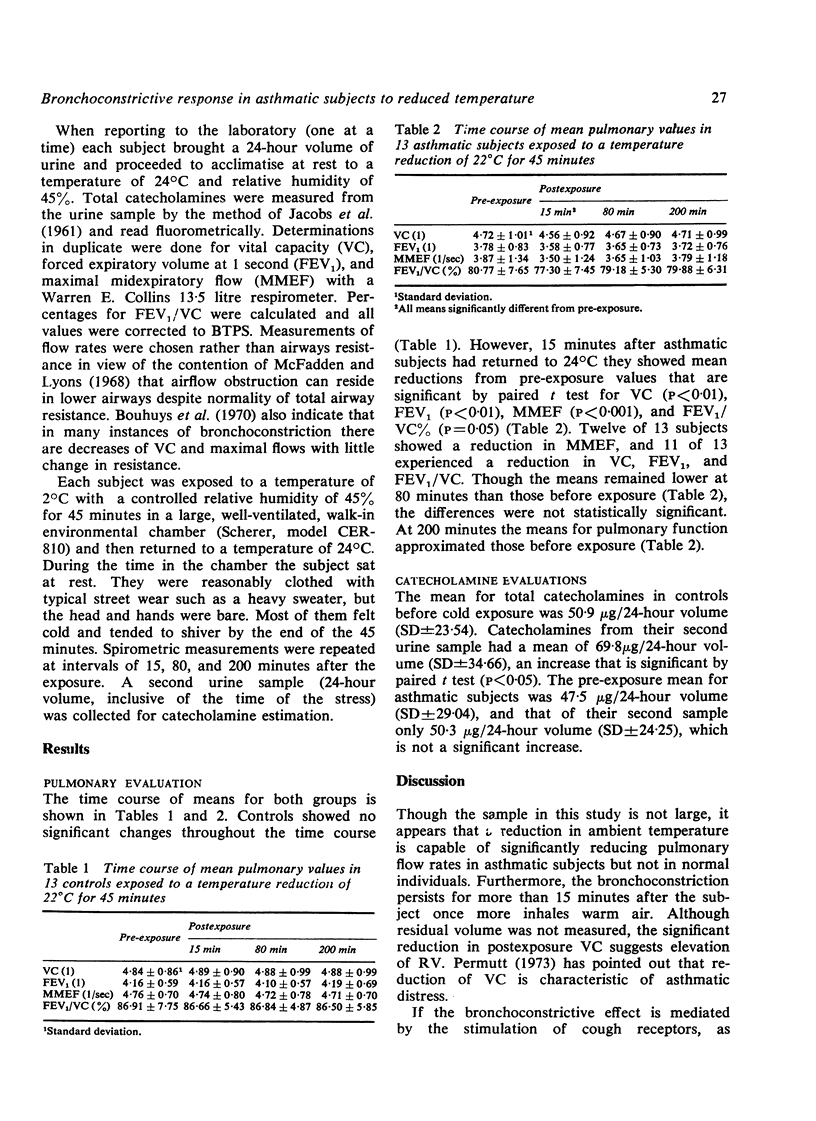Abstract
Thirteen young adults with bronchial asthma and a like number of controls were subjected for 45 minutes to a temperature of 2 degrees C after leaving a temperature of 24 degrees C to which they subsequently returned. Pre-exposure examination included VC, FEV1, MMEF, FEV1/VC%, and urinary catecholamines. The pulmonary measurements were repeated at 15, 80, and 200 minutes after exposure. Catecholamines were measured from a second urine sample, the collection of which corresponded to the period during and after the stress. Controls showed no significant pulmonary changes throughout the time of study, but 15 minutes after exposure the asthmatic subjects showed a significant mean decrease of all pulmonary measurements from pre-exposure values. The controls showed a significant mean increase in urinary catecholamines after the stress, whereas those with asthma showed no significant increase.
Full text
PDF


Selected References
These references are in PubMed. This may not be the complete list of references from this article.
- Bouhuys A., Van de Woestijne K. P. Respiratory mechanics and dust exposure in byssinosis. J Clin Invest. 1970 Jan;49(1):106–118. doi: 10.1172/JCI106209. [DOI] [PMC free article] [PubMed] [Google Scholar]
- Cabezas G. A., Graf P. D., Nadel J. A. Sympathetic versus parasympathetic nervous regulation of airways in dogs. J Appl Physiol. 1971 Nov;31(5):651–655. doi: 10.1152/jappl.1971.31.5.651. [DOI] [PubMed] [Google Scholar]
- Greenburg L., Field F., Reed J. I., Erhardt C. L. Asthma and temperature change. II. 1964 and 1965 epidemiological studies of emergency clinic visits for asthma in three large New York City hospitals. Arch Environ Health. 1966 May;12(5):561–563. doi: 10.1080/00039896.1966.10664433. [DOI] [PubMed] [Google Scholar]
- JACOBS S. L., SOBEL C., HENRY R. J. Specificity of the trihydroxyindole method for determination of urinary catecholamines. J Clin Endocrinol Metab. 1961 Mar;21:305–314. doi: 10.1210/jcem-21-3-305. [DOI] [PubMed] [Google Scholar]
- Janský L., Bartůnková R., Zeisberger E. Acclimation of the white rat to cold: noradrenaline thermogenesis. Physiol Bohemoslov. 1967;16(4):366–372. [PubMed] [Google Scholar]
- Mathé A. A., Knapp P. H. Decreased plasma free fatty acids and urinary epinephrine in bronchial asthma. N Engl J Med. 1969 Jul 31;281(5):234–238. doi: 10.1056/NEJM196907312810503. [DOI] [PubMed] [Google Scholar]
- Ramsey J. M. The relation of urban atmospheric variables to asthmatic bronchoconstriction. Bull Environ Contam Toxicol. 1976 Jul;16(1):107–111. doi: 10.1007/BF01753114. [DOI] [PubMed] [Google Scholar]
- Simonsson B. G., Jacobs F. M., Nadel J. A. Role of autonomic nervous system and the cough reflex in the increased responsiveness of airways in patients with obstructive airway disease. J Clin Invest. 1967 Nov;46(11):1812–1818. doi: 10.1172/JCI105671. [DOI] [PMC free article] [PubMed] [Google Scholar]
- Tromp S. W. Influence of weather and climate on asthma and bronchitis. Rev Allergy. 1968 Nov;22(11):1027–1044. [PubMed] [Google Scholar]
- WELLS R. E., Jr, WALKER J. E., HICKLER R. B. Effects of cold air on respiratory airflow resistance in patients with respiratory-tract disease. N Engl J Med. 1960 Aug 11;263:268–273. doi: 10.1056/NEJM196008112630602. [DOI] [PubMed] [Google Scholar]


